Most swimming pool owners face two main concerns, the first one being limited use of their pool during the cold off-season and the second being the high maintenance costs— especially for heated pools!
But what if there was a way to heat your pool for free?
A solar energy-powered heater can help you do just that. Delve into this guide to discover the many different solar swimming pool heating options at your disposal.
—
SUMMARY
- Why install solar heating for your swimming pool?
- How solar swimming pool heating works
- The various swimming pool-heating technologies
- Components of a DualSun heating system for swimming pools
- The advantages and disadvantages of heating your swimming pool with solar energy
- How many hybrid solar panels does it take to heat a pool?
- Installation and heating costs of solar panels for swimming pools
Why install solar heating for your swimming pool?
Did you know that the ideal water temperature for swimming pools lies between 26 and 29°C? To achieve this, you will need to rely on a swimming pool heating solution.
With this in mind, we cannot recommend solar swimming pool heating highly enough. For one, it makes sense. For another, it is economical. Last but not least, it is environmentally-friendly!
Solar heating makes sense
A solar heating system provides inexhaustible energy for free! How can anyone say no to that?
Let us add that solar energy is an efficient source of energy no matter where you live. After all, it is no secret that Germany is well ahead of the curve as far as renewable energy is concerned. And this is true despite the fact that Bavaria is no French Riviera!
Solar heating is cost-effective
Solar heating allows you to save on your electricity bills and extend the use of your swimming pool throughout the year, thus rendering the pool more “profitable.” To sum up, solar heating is an inexpensive way to heat your swimming pool.
The table below compares different pool heating systems in terms of operating costs (heating and pump supply) in France.
The analysis comprised 5 months of use (from May to September) and was conducted on an 8 x 4 meter covered pool located in a temperate zone (source: Distripool).
Solar heating is environmentally-friendly
Using solar energy to heat your swimming pool is an environmentally-friendly choice because it does not release any greenhouse gases or hazardous waste into the atmosphere during operation.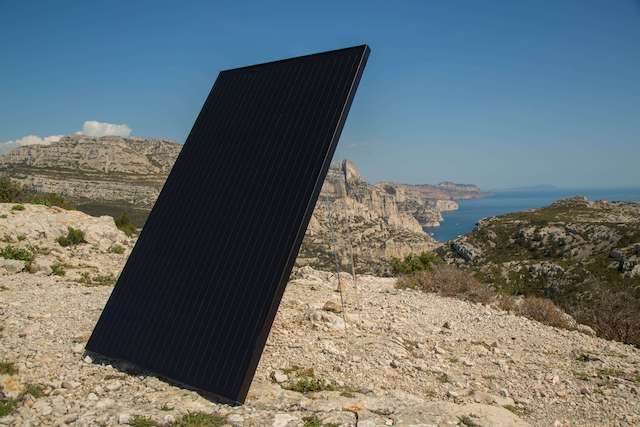 By opting for solar energy, you eschew fossil fuels and thus help prevent global warming.
By opting for solar energy, you eschew fossil fuels and thus help prevent global warming.
Using a conventional swimming pool heater comes with a high economic and environmental impact. This is because it operates with an electrical resistance fed by the grid. It is controlled by a thermostat, just like a conventional electric heater. This type of electric heater is particularly energy-consuming.
So you see, solar solutions have a very weak environmental impact compared to other options. Solar energy is clean and solar panels are over 94% recyclable!
Do not forget the importance of seeking an expert opinion to get a clearer picture of the subject of solar pool heating.
[et_bloom_inline optin_id=”optin_14″]
How solar swimming pool heating works
As its name suggests, a solar-heated swimming pool is heated through solar energy. This kind of heating can raise the temperature of the water by up to 5°. A considerable increase! By harnessing solar radiation, you can enjoy your pool for longer.
Rest assured that a solar swimming pool heating system works in a fairly simple way:
- The water that flows through the filter circuit is diverted to the solar heating system.
- The water is filtered and then heated with the help of swimming pool solar collectors.
- Lastly, the water is transferred back into the swimming pool itself.
The water can also be heated by various other means, such as solar domes or solar heating mats placed in front of the pool. The water then flows through a pipe system, is heated, and retransferred into the pool. This is a good way to heat an above-ground pool.
The solar water heater for swimming pools is convenient and user-friendly.
It is usually placed in proximity to the swimming pool to avoid heat loss. The layout of this renewable energy system therefore depends on the layout of the garden itself. At any rate, the heating system is connected to the water circuit, then to the water pump and the filter.
Read our article describing : how solar panels work
The various swimming pool-heating technologies
Heat-conserving tarps
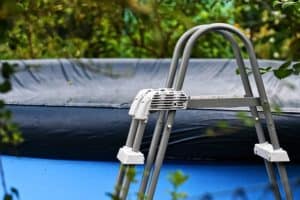 The easiest way to heat your water is by placing a bubble tarp over the swimming pool. The tarp serves three purposes: protects the water from impurities, limits the formation of algae, and conserves heat. To achieve these benefits, simply lay a plastic tarp over your installation. This type of tarp is available at any swimming pool shop.
The easiest way to heat your water is by placing a bubble tarp over the swimming pool. The tarp serves three purposes: protects the water from impurities, limits the formation of algae, and conserves heat. To achieve these benefits, simply lay a plastic tarp over your installation. This type of tarp is available at any swimming pool shop.
The tarp is an inexpensive heating option that sells for less than 10 euros per m2. Some may refer to it as a “solar tarp” or a “solar pool cover,” but they would be incorrect. The rays of sun simply heat the plastic and therefore the water found underneath, but it is not a solar technology, per se.
On the other hand, this type of heating is much less efficient than solar heating. While using a tarp is a first essential step before proceeding to install solar panels, it does not suffice in most situations.
Our thoughts on using tarps for swimming pool heating: It is a basic means of preventing heat loss at night or on windy days. It conserves a few degrees Celsius but should not be counted upon to really heat a pool.
Solar mat
The solar mat (also known as solar carpet or heating carpet) is made up of flexible black hoses. Easy to handle, the unrolled mat is laid down near the pool and is connected to the filtration system. It can be moved and rolled up again for storage.
Solar mats may be purchased from any pool dealer. A good quality mat will cost you between €100 and €200 per square meter. To be effective, the surface area of the solar mat must be equal to 30 to 60% of the total surface area of your pool. Make sure you have enough space!
Our thoughts on using solar mats for swimming pool heating: A cost-effective solution. However, it seldom suffices to adequately heat a swimming pool when used on its own. It works best when combined with a bubble tarp.
Heat pumps
This is the most commonly used pool heating method in France. It refers to either an air-to-water heat pump or a ground-to-water heat pump. Thus, the warmer the weather, the less energy it needs to perform its heating functions.
Here are the purchase prices for this technology. Average price of a swimming pool heat pump (prices observed in France ):
[table id=19 /]
Swimming pools that are equipped with a heat pump require space. They are often linked to a thermostat, but also to the swimming pool water filtration circuit. The heat pump extracts heat from the air (or the ground) and then warms up the water. It is a suitable solution for solar heating of above-ground or in-ground swimming pools.There are also heat pumps that warm both the house and the swimming pool. They sell at an average price of €12,000 each.
The benefit of using a heat pump is that it works in all weather conditions.
Although the heat pump is a much more cost-efficient way of heating your swimming pool compared to an electric heater or a gas boiler, the pump needs electricity to heat the swimming pool, and this can translate into expensive gas bills. Additionally, some of the models can be noisy. Lastly, there are no tax incentives for swimming pool heat pumps.
What is the electricity consumption cost of a heat pump?
Based off the assumption that a regular swimming pool is around 32 m2 (4×8) and 1.5 m deep, the swimming pool guide tells us to calculate an average consumption cost of €2.50 to €3.70/m3 when using an air-to-water heat pump for pool heating. The ground-to-water heat pump, on the other hand, is an even more cost-effective solution. Its consumption averages between €2.30 and €3.50/m3 of heated pool water.
Once again, bear in mind that a heat pump consumes electricity just as a conventional solar pool heater does, which can significantly increase your energy bill.
Using solar heating on a 50m3 swimming pool is all the more costly!
Our thoughts on using heat pumps for swimming pool heating: It is an efficient, albeit cumbersome technique. It can also spike up energy consumption, which is particularly unfortunate given the yearly increases in electricity costs. On the other hand, it comes at an affordable purchase price. It’s a shame that it must be connected to the electricity grid. It would be optimal if coupled with solar technology!
Traditional thermal solar panels
This is the most cost-effective solution.
A thermal solar panel uses solar energy to increase the temperature of swimming pool water. The thermal panel absorbs solar radiation and converts it into heat, then transfers that heat into the water in the pool. In this system, the thermal panel acts as a solar swimming pool heater.
These panels use renewable, unlimited, and free energy. Apart from the filter pump, which does consume energy, the thermal panels require little electrical energy to operate. There is almost no additional operating cost associated with them. All in all, this solar swimming pool heater will cost you nothing more but the price of its initial purchase.
What is the electricity consumption cost of a thermal solar installation?
Here we are referring to a simple swimming pool heating panel.
As you may have guessed, a thermal solar panel is only used for water heating purposes. This means that it will not cover the swimming pool’s electrical consumption, which can be very high when taking the filter pump into account. In fact, the filter pump consumes an estimated average of 1260 kWh per year.
Take for instance a 0.5 kW solar swimming pool filter pump that runs 12 hours a day for 7 months. Therefore, 0.5 kW x 12 (hours per day) x 30 (days per month) x 7 (months) = 1260 kWh per year.
Prices vary from country to country. For instance, according to the June 2019 EDF “blue price” grid with a basic rate option, the cost of running a filter pump in France would be €0.17/kWh x 1260 = €214/year. When considering that electricity costs are relentlessly increasing at an estimated 3.03% per year, the average electricity consumption cost of a thermal solar installation is €370/year for 20 years.
Our thoughts on using thermal panels for swimming pool heating: This is a robust solution because the lifespan of a thermal panel exceeds 30 years. Moreover, it is very profitable and does not emit any greenhouse gases. However, like all solar energy systems, its efficiency largely depends on the weather. Feel free to use it in combination with a swimming pool bubble tarp.
2 in 1 hybrid solar panels
Here is the most profitable solution.
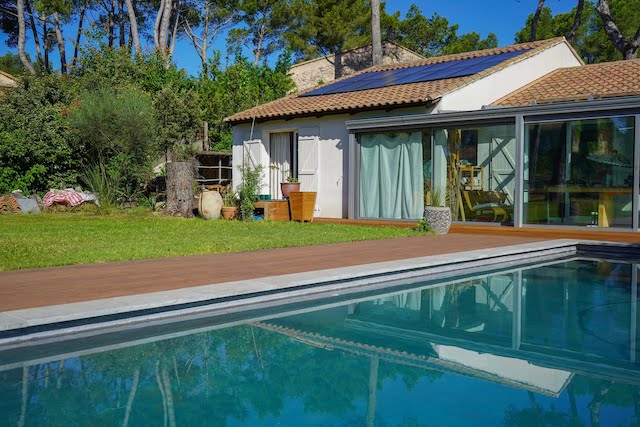 This is a system that ensures your swimming pool’s energy autonomy.
This is a system that ensures your swimming pool’s energy autonomy.
Hybrid solar panels such as the ones by DualSun offer two solutions in one. This makes them more versatile and profitable.
The first is a thermal heat-creating technology. In a swimming pool setup, it is used to directly heat the pool water. The filtered pool water flows through the hybrid panels and the panels heat it up. This technology extends the swimming season by up to 3 months a year.
The second is an energy-generating photovoltaic technology. If properly sized, the installation can cover the energy consumption of the filter pump. Conveniently enough, the pump runs mainly during the day when the panels also generate energy.
How does solar hybrid technology work?
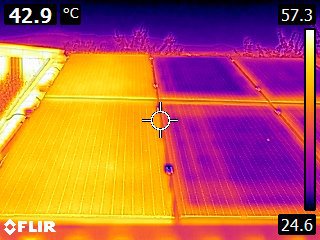
It should be noted that the electrical efficiency of the photovoltaic cells in the panel decreases as its temperature rises. As a result, a cooled solar panel generates more energy on the right: Spring hybrid panel (cooled), on the left: conventional photovoltaic panel (uncooled)
Based on this principle, the water circulates through the DualSun hybrid panels and cools them down. The panels can be cooled down in a very efficient manner by the swimming pool, which is essentially a large reservoir of cold water that ensures the panels are kept at a low temperature.
Hybrid panels are more efficient at producing electricity than photovoltaic panels of equivalent power, so there is a double benefit to heating a swimming pool with hybrid panels.
Our thoughts on using hybrid panels for swimming pool heating: It is a very advantageous technology that ensures a swimming pool’s renewable energy autonomy. On the one hand, the thermal component heats the swimming pool. On the other, the photovoltaic component powers the system. This technology goes very well with a heat pump.
[et_bloom_inline optin_id=”optin_14″]
Components of a Dualsun heating system for swimming pools
To get started with Dualsun’s solar panels for swimming pool heating, you will need:
- Dualsun hybrid panels
- The possibility of connection to a heat pump
- The possibility of using a solar water heater that also acts as a swimming pool heater (Individual Solar Water Heater with Discharge in Swimming Pool, or CESI Décharge piscine in French)

Schematic diagram of a DualSun individual solar heating installation for swimming pools
- The filter pump: it filters the water in the swimming pool and is located before the panels to prevent them from clogging.
- The pilot valve: it enables pool water to be directed towards the solar panels when they become warmer than the water in the swimming pool.
- The air-to-water heat pump: This is an optional item that provides additional heat for greater convenience, but consumes electricity. Part of its consumption can be covered by connecting it to hybrid solar panels.
These installations are generally more integrated into the home than a simple solar water heater. The panels can be mounted onto the roof and the surplus electricity can be fed back into the house. In this case, the electrical energy generated by the solar panels must pass through an inverter which transforms the direct current from the panels into alternating current fit for household use.
Individual Solar Water Heater with Discharge in Swimming Pool (CESI Décharge piscine in French)
Dualsun has have developed a system that makes the most of solar energy. It is called the “Individual Solar Water Heater with Discharge in Swimming Pool” and is the best solution on the market.
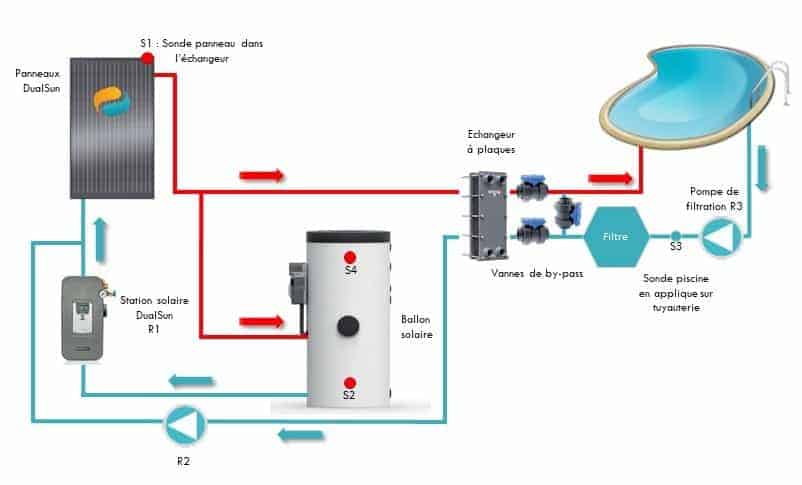
Schematic diagram of a “ISWH with Discharge in Swimming Pool” solar heating installation
In this configuration, the solar installation is connected to both the solar hot water tank and the swimming pool. Within this system, the panels first heat the solar water heater. Once the water in the solar water tank is heated, it is fed into the pool.
What are the benefits?
- Better photovoltaic efficiency compared to a traditional ISWH due to the more effectively water-cooled panels
- Energy autonomy and free solar heating for your swimming pool
Conversely, this configuration requires the swimming pool to be located close to the house. This very system is implemented in an exemplary project in Cabriès. Have a look!
The advantages and disadvantages of heating your swimming pool with solar energy
Thermal solar panel
Advantages:
- Thermal solar panels absorb solar energy, which is free and inexhaustible, and do not require electricity to produce hot water.
That is why functioning solar panels are more cost-efficient than a heat pump. A heat pump requires electrical energy in order to function. - Thermal solar panels are guaranteed to enhance your energy autonomy from the traditional energy grid.
- It is a robust and low-maintenance
- It qualifies for government aid.
Disadvantages:
- Thermal solar panels are still subject to the vagaries of the weather and the seasons. They generate less energy in the springtime and the fall, which may be a sticking point for individuals seeking the utmost comfort.
- Thermal solar panels do not generate electricity for the swimming pool pump (unlike hybrid panels).
- It is important to ensure the proper sizing of the installation so that the thermal solar panels do not overheat.
Hybrid solar panel
 The main distinguishing feature of the hybrid solar panel is that it embodies both photovoltaic cells and thermal technology.
The main distinguishing feature of the hybrid solar panel is that it embodies both photovoltaic cells and thermal technology.
Thanks to this dual technology, the hybrid solar panel covers the swimming pool’s electric consumption and heats the water at the same time. This means that you can drastically reduce your electricity bills while enjoying free solar heating!
To sum up, in addition to the advantages of basic solar panels, there are four additional fundamental advantages to heating your swimming pool with hybrid panels.
Remember, they are both photovoltaic and thermal.
- Reduction of the electricity consumption associated with running the swimming pool. Operating the swimming pool requires a lot of electricity!
- Free heating of your swimming pool.
- Maximum solar efficiency. Given that the swimming pool permanently cools down the solar panels and cooled solar panels generate more electricity, the installation offers the shortest return on investment.
- The possibility of connecting it to a heat pump for “free” due to the electric output.
You may add a heat pump to supplement the heating system without experiencing a significant increase in your bills. This is due to the fact that the heat pump can consume the electricity generated by the panels. In addition, its lifespan will be longer than that of a system consisting of just a heat pump and no panels. The hot water supplied by the panels means less work for the pump given that the water is already partially heated.
Nevertheless, as with thermal panels, the hybrid panel is weather-dependent. If it is very sunny outside, the panel generates surplus electricity. This surplus can be fed back into your home to power your electrical appliances or an electric car. On the other hand, if the weather is cloudy, solar activity is inevitably reduced.
[et_bloom_inline optin_id=”optin_14″]
How many hybrid solar panels does it take to heat a pool?
The number of panels needed to heat your pool depends on its surface area and volume. The geographical location should also be taken into account. For instance, the panels will have a higher efficiency in the south of France because the region boasts more regular sunshine.
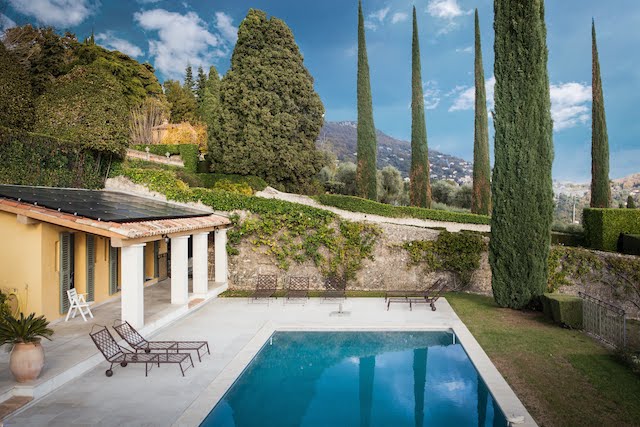
To determine the number of panels to be installed, one must know the swimming pool’s heat loss surface, meaning the surface exposed to the air. In the case of an underground pool, this means the surface of the pool only.
With this in mind, the next step requires accounting for the regional climate. In the south of France, for instance, it is recommended that the surface occupied by the solar panels represent at least 50% of the swimming pool’s heat loss surface. In the north, this number is something like 75%. In both of these cases, the panels will increase the temperature by 2 to 4°C depending on the amount of sunshine available.
Consequently, in the south, one should install 5m² of DualSun panels per every 10m² of swimming pool surface area. In the north, 7.5m² of panels per every 10m² of swimming pool surface area.
As an example, an 8 x 4m underground swimming pool in the south of France will require: 8 x 4 x 50% = 16m² of panels, or 3kWc.
For more information, read the following article: How many DualSun Spring panels are needed to heat a pool?
Installation and heating costs of solar panels for swimming pools
With thermal solar panels
To set up your installation, you can look into the option of a solar swimming pool heating kit. You must choose the right kit for the size of your swimming pool. It costs between €600 and €3,500.
In any event, this type of installation is simple if you are a DIY enthusiast. We recommend calling in a professional installer for anything relating to warranties or proper operation.
Some have even chosen to build their own solar installation. With that being said, this kind of project is not for everyone. It requires mounting a structure, creating a hydraulic network or even putting together the front side of the panel itself.
With hybrid solar panels
DualSun offers a hybrid technology that can be mounted on the roof of the house just like classic photovoltaic solar panels.
The multiple benefits offered by a hybrid installation make it a very advantageous, yet slightly more expensive option. More than just a simple swimming pool heater, these hybrid panels can be used all year round to help you achieve energy autonomy
To obtain your personalized estimate, use our online simulator: MyDualsun
For further reading, we recommend:
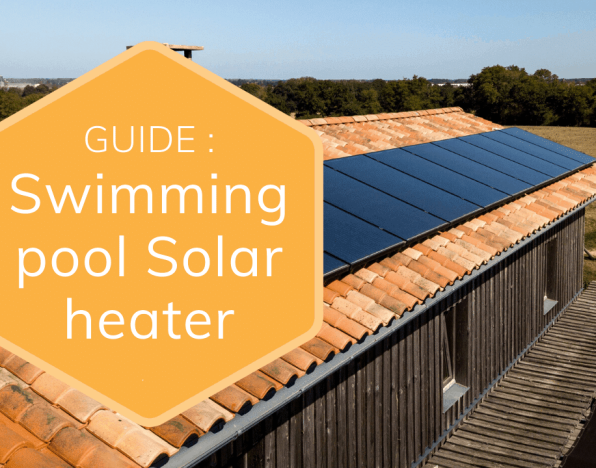

2 comments
Edwards
Hi
Is there a minimum distance for a pv solar panel to be away from a swimming pool
I am thinking about erecting a fence around my pool and want to use pv bifacial panels fitted with microinverters
Thank You
Sam
Marine de Dualsun
Hello Sam,
Thanks for your message.
There is no maximum distance to respect per se but it is of course recommended to limit it to avoid heat loss. On a swimming pool type application, the energy loss over 10 meters is 4%; over 20 meters it is 8%. These losses remain acceptable though.
Marine, from Dualsun